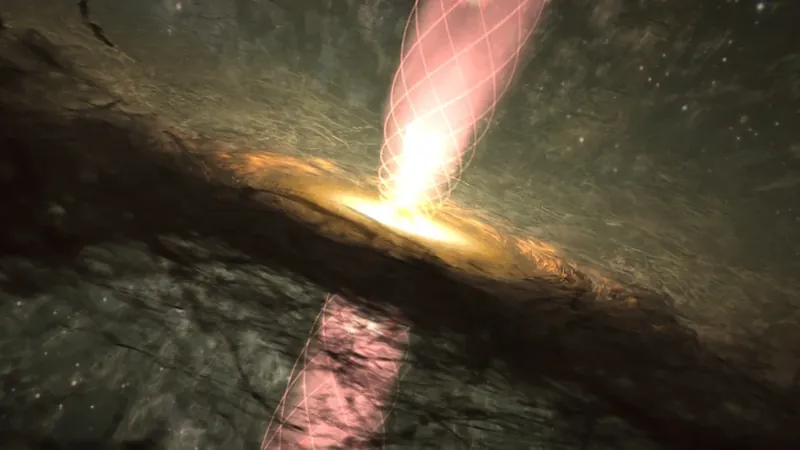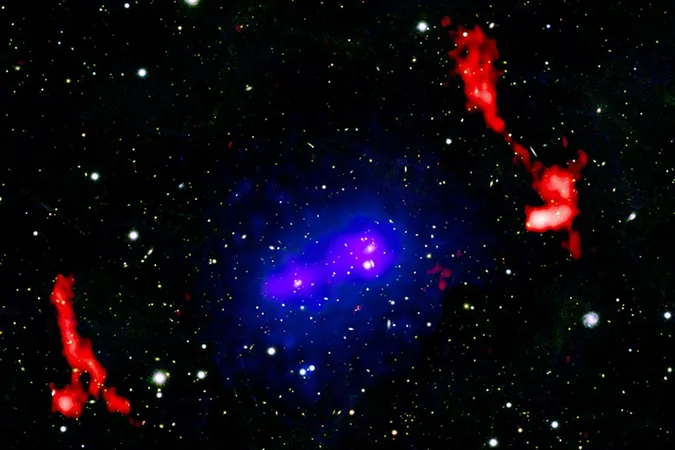
Groundbreaking Discovery: First 3D Visualization of Helical Magnetic Field in Protostellar Jets
2025-01-12
Author: Liam
Groundbreaking Discovery: First 3D Visualization of Helical Magnetic Field in Protostellar Jets
A team of astronomers, spearheaded by Adriana Rodríguez-Kamenetzky and Alice Pasetto, has made a groundbreaking discovery: the first-ever 3D visualization of a helical magnetic field within the HH 80-81 protostellar jet. This remarkable study was conducted at the Institute of Theoretical and Experimental Astronomy (IATE) in Argentina, affiliated with the National Scientific and Technical Research Council (CONICET) and the National University of Córdoba (UNC).
Understanding Protostellar Jets
Protostellar jets are explosive streams of matter and energy, commonly observed in celestial systems where accretion occurs around central objects such as young stars and supermassive black holes. Despite extensive research, the exact mechanisms behind the collimation—how these jets maintain their narrow shape—have long remained a mystery.
A Historic Find in HH 80-81
The newly studied HH 80-81 jet, powered by a massive protostar located approximately 1,200 to 1,400 parsecs—equivalent to 3,900 to 4,570 light years—in our Milky Way galaxy, has now provided unequivocal evidence of a helical magnetic field. This type of magnetic field has been previously observed in jets emanating from galaxies with supermassive black holes, suggesting a potentially universal phenomenon. "This is the first solid evidence that helical magnetic fields can explain astrophysical jets at different scales, supporting the universality of the collimation mechanism," remarked lead researcher Adriana Rodríguez-Kamenetzky.
Advanced Research Techniques
The research team utilized the upgraded National Science Foundation's Very Large Array (NSF VLA) over four observation sessions in November and December 2018, accumulating a total of 20 hours of data. They focused on the 4 to 8 GHz frequency range, employing sophisticated data analysis techniques, including Rotation Measure (RM) analysis, which allowed for the accurate examination of the jet’s magnetic field structure.
Unveiling the 3D Magnetic Field Structure
The innovative analysis revealed a helical configuration in the HH 80-81 jet's magnetic field resulting from the combined effects of poloidal and toroidal magnetic components created by the rotation of the protostar's accretion disk. The observations of transverse RM gradients provided critical insights into the magnetic landscape, confirming theoretical models that explain how astrophysical jets are focused and directed.
Significance of the Findings
Researchers estimated the line-of-sight magnetic field strength within the jet to be around 0.1 milligauss, reinforcing the helical configuration. Alice Pasetto, a co-researcher and professional astronomer from the Institute of Radio Astronomy and Astrophysics (IRyA) of the National Autonomous University of Mexico (UNAM), stated, “For the first time, we were able to study the 3D configuration of the magnetic field in a protostellar jet.”
The ability to observe both the jet and its counterjet simultaneously also allowed for an unprecedented verification of the helical magnetic field's origins, showing it is generated within the jet-disk system rather than influenced by external forces.
The Bigger Picture
The implications of these findings extend beyond just one protostellar jet. They strongly suggest that helical magnetic fields may play a universal role in shaping and collimating astrophysical jets across various cosmic scales. This insight aligns with similar magnetic structures observed in jets from distant active galactic nuclei, revealing a common underlying mechanism at work throughout the universe.
As researchers look toward the future, advancements in technology, such as the Square Kilometre Array (SKA) and the Next Generation Very Large Array (ngVLA), promise to enhance our ability to investigate magnetic fields in smaller-scale jet-producing objects, leading to deeper insights into the very fabric of our universe.
Stay tuned for more astonishing discoveries in astrophysics as we continue to unlock the mysteries of the cosmos!









 Brasil (PT)
Brasil (PT)
 Canada (EN)
Canada (EN)
 Chile (ES)
Chile (ES)
 Česko (CS)
Česko (CS)
 대한민국 (KO)
대한민국 (KO)
 España (ES)
España (ES)
 France (FR)
France (FR)
 Hong Kong (EN)
Hong Kong (EN)
 Italia (IT)
Italia (IT)
 日本 (JA)
日本 (JA)
 Magyarország (HU)
Magyarország (HU)
 Norge (NO)
Norge (NO)
 Polska (PL)
Polska (PL)
 Schweiz (DE)
Schweiz (DE)
 Singapore (EN)
Singapore (EN)
 Sverige (SV)
Sverige (SV)
 Suomi (FI)
Suomi (FI)
 Türkiye (TR)
Türkiye (TR)
 الإمارات العربية المتحدة (AR)
الإمارات العربية المتحدة (AR)